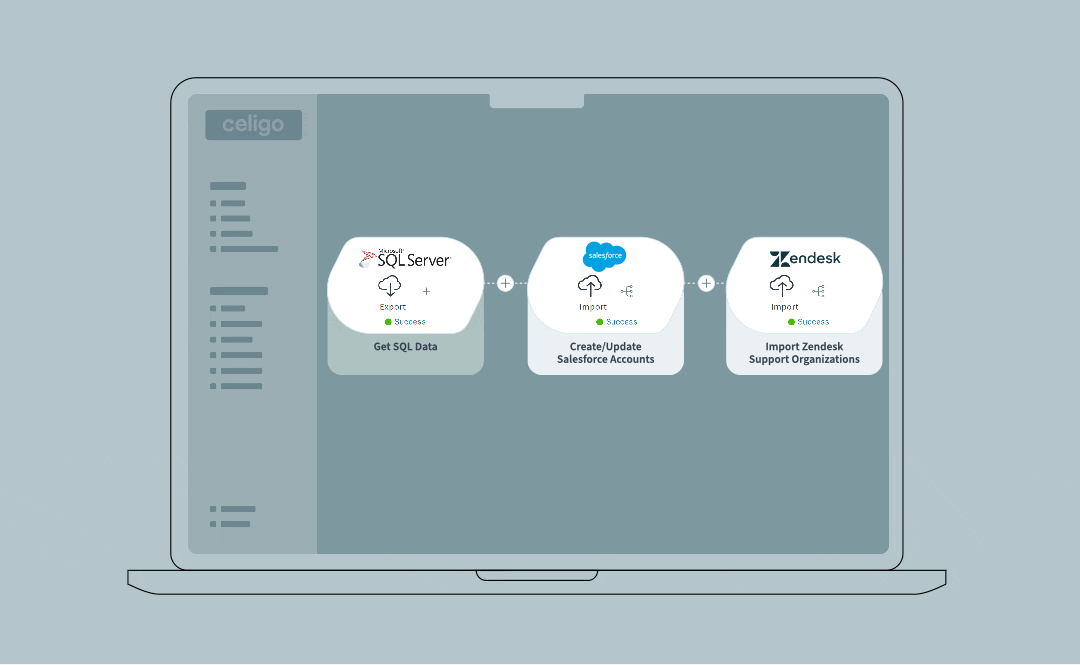Published Dec 5, 2023
ESB vs. iPaaS
Explore the core features of Enterprise Service Bus (ESB) and Integration Platform as a Service (iPaaS) and compare their capabilities

ESB (Enterprise Service Bus) and iPaaS (integration Platform as a Service) are both integration solutions used in enterprise application architectures. While they serve similar purposes of facilitating communication and data sharing between applications and systems, there are several key differences between ESB and iPaaS.
Key takeaways: Comparing ESB & iPaaS
-
ESB is a software architecture that facilitates data and message exchange between multiple applications.
- iPaaS is an integration solution that provides a platform for connecting applications, systems, and data.
-
ESB solutions primarily focus on message-level integration, routing, and transformation, and since they are often deployed on-premise, they can be expensive and time-consuming to maintain.
-
iPaaS operates in the cloud and offers broader capabilities beyond messaging, making it ideal for scalability and flexibility.
Definitions
Before we get into the similarities and differences, let’s first define each of these technologies.
ESB
An Enterprise Service Bus (ESB) is a software architecture and integration framework that facilitates the exchange of data and messages between multiple applications and systems within an enterprise. It serves as a central communication and integration hub, enabling seamless connectivity, message routing, transformation and mediation between disparate systems and applications.
At its core, an ESB provides a set of services and capabilities that enable interoperability and communication between different components of an enterprise’s IT infrastructure. These services typically include message queuing, routing, protocol conversion, data transformation and service mediation. An ESB acts as a mediator, facilitating communication while abstracting the underlying complexity of the systems involved.
The primary purpose of an ESB is to enable the integration of various applications, services and endpoints, regardless of their underlying technologies, platforms, or protocols. It provides a standardized approach to integration, allowing organizations to leverage existing systems and applications while adding new ones without the need for extensive custom coding or point-to-point integrations.
The key features of an ESB typically include:
- Message-oriented middleware: An ESB facilitates the exchange of messages between systems using message queues, topics, or channels, ensuring reliable and asynchronous communication.
- Message transformation: The ESB can transform and manipulate messages between different formats, protocols, or data models, allowing systems with incompatible interfaces to communicate effectively.
- Protocol and transport mediation: The ESB supports various communication protocols, such as HTTP, SOAP, JMS, and FTP, enabling seamless integration across heterogeneous systems.
- Routing and orchestration: The ESB provides routing capabilities to direct messages to the appropriate destinations based on predefined rules or conditions. It can also support complex orchestration of services and workflows.
- Service virtualization and abstraction: An ESB abstracts underlying services and systems, allowing applications to interact with them without direct knowledge of their specific details or locations.
- Monitoring and management: ESBs often include monitoring and management capabilities, providing visibility into message flows, performance metrics, error handling, and logging for troubleshooting and operational control.
Overall, an ESB acts as a middleware layer that enables efficient and scalable integration within an enterprise. It promotes loose coupling, reusability and agility by providing a standardized integration framework that simplifies the development, maintenance and management of interconnected systems.
iPaaS
iPaaS (Integration Platform as a Service) is a cloud-based integration solution that provides a comprehensive platform for connecting and integrating various applications, systems, data sources and services within an organization. It offers a range of tools, services and pre-built connectors to facilitate seamless data exchange and process automation.
See What is iPaaS?
The key features of an iPaaS typically include:
- Cloud-based Integration: iPaaS solutions are cloud-native and operate as a fully managed service. They leverage the scalability, flexibility and accessibility of the cloud to enable integration between on-premises systems, cloud-based applications and external services.
- Connectivity and Adapters: iPaaS platforms provide a wide array of pre-built connectors and adapters that simplify the integration process. These connectors often support popular applications, databases, APIs, and cloud services, allowing organizations to quickly establish connections and exchange data between systems.
- Data Integration and Transformation: iPaaS platforms offer data integration capabilities, including data mapping, transformation, and synchronization. They enable organizations to harmonize and consolidate data from multiple sources, ensuring consistent and reliable information across systems.
- API Management: iPaaS platforms often include API management functionality, allowing organizations to expose their own APIs for internal or external consumption. This facilitates the creation of integration interfaces, enabling seamless interaction with business partners, customers, and third-party systems.
- Workflow Automation: iPaaS solutions enable the creation of workflows and business processes through visual design tools or low-code development environments. This allows organizations to automate data flows, orchestrate complex integration scenarios, and streamline business operations.
- Event-driven Architecture: iPaaS platforms support event-driven architectures, enabling real-time data processing and event-driven workflows. They can listen for specific events or triggers and automatically initiate actions or workflows based on those events.
- Monitoring and Management: iPaaS solutions provide monitoring and management capabilities to track the performance, availability, and reliability of integrations. They often include dashboards, logging, and alerting mechanisms to proactively identify and resolve issues.
- Security and Governance: iPaaS platforms prioritise security and compliance. They typically offer features such as data encryption, access control, user authentication, and audit trails to ensure data privacy and protection.
- Scalability and Elasticity: iPaaS solutions are designed to scale resources dynamically based on demand. This allows organizations to handle varying workloads efficiently without the need for significant infrastructure changes or capacity planning.
- Subscription-based Pricing: iPaaS platforms follow a subscription-based pricing model, where organizations pay based on usage, the number of integrations, and required features. This pricing approach offers flexibility and cost-effectiveness, as organizations can scale their usage up or down as needed.
The primary purpose of an iPaaS is to provide a comprehensive and user-friendly approach to integration, enabling organizations to connect their systems, automate processes and leverage the benefits of cloud-based technologies.
Comparison
Now that we have the definitions clear, let’s compare the two technologies.
Architecture
- ESB: ESB follows a hub-and-spoke architecture. It centrally manages the integration process, acting as a central message broker that connects various applications and systems. It typically relies on an on-premises deployment model.
- iPaaS: iPaaS follows a cloud-based multi-tenant architecture. It provides a comprehensive integration platform hosted in the cloud, accessible through the internet. It leverages cloud services and APIs to connect applications and systems.
Deployment Model
- ESB: ESB solutions are often deployed on-premises within an organization’s infrastructure. This requires dedicated hardware and IT resources for installation, configuration, and maintenance.
- iPaaS: iPaaS solutions are cloud-based and provided as a service. They are hosted and maintained by the iPaaS provider, eliminating the need for on-premises infrastructure. Users can access and configure the integration platform through a web-based interface.
Scalability and Flexibility
- ESB: ESB solutions can handle a high volume of transactions and provide robust scalability. However, scaling an on-premises ESB may require additional hardware and infrastructure investments.
- iPaaS: iPaaS solutions inherently offer scalability and flexibility due to their cloud-based nature. They can dynamically scale resources based on demand, allowing organizations to handle varying workloads without the need for significant infrastructure changes.
Connectivity and Adapters
- ESB: ESBs typically provide a wide range of built-in adapters and connectors to facilitate connectivity with various systems and protocols. They often require custom development or configuration to integrate with specific applications.
- iPaaS: iPaaS platforms offer pre-built connectors and adapters for integrating with a broad range of applications, databases, APIs, and cloud services. This simplifies the integration process and reduces the need for custom development.
Focus and Capabilities
- ESB: ESB solutions primarily focus on message-level integration, routing, and transformation. They excel at handling complex integration scenarios, supporting multiple communication protocols, and enforcing message-based policies and transformations.
- iPaaS: iPaaS solutions offer broader integration capabilities beyond messaging, including data integration, API management, event-driven architectures, and workflow automation. They provide a more comprehensive suite of tools and services for managing end-to-end integrations.
Cost Model
- ESB: ESB solutions often involve upfront costs for hardware, software licenses, and infrastructure setup. They may also require ongoing maintenance and support expenses, typically handled by in-house IT teams.
- iPaaS: iPaaS solutions follow a subscription-based pricing model, where users pay based on usage, the number of integrations, and the required features. This allows organizations to align costs with actual usage and avoid significant upfront investments.
Maintenance and Upgrades
- ESB: ESB solutions require organizations to handle maintenance, upgrades, and infrastructure management in-house. This may require dedicated IT resources and expertise.
- iPaaS: iPaaS providers handle maintenance, upgrades, and infrastructure management, allowing organizations to focus on integration development and business needs without worrying about underlying infrastructure.
Ecosystem and Community
- ESB: ESB solutions have been in the market for a longer time and often have a well-established community and ecosystem. They may offer a larger pool of resources, documentation, and community support.
- iPaaS: iPaaS platforms have gained significant popularity in recent years and have a growing ecosystem. They may have a more modern and agile community, with an emphasis on cloud-native integration practices.
It’s worth noting that the boundaries between ESB and iPaaS are becoming less distinct as integration technologies evolve. Some iPaaS solutions are incorporating ESB-like capabilities, while ESBs are adapting to cloud-based deployment models. The choice between ESB and iPaaS depends on specific integration requirements, existing infrastructure, scalability needs, and the level of control and customization desired by an organization.
Integration insights
Expand your knowledge on all things integration and automation. Discover expert guidance, tips, and best practices with these resources.




